key CHEVROLET ASTRO PASSENGER 1994 1.G Owners Manual
[x] Cancel search | Manufacturer: CHEVROLET, Model Year: 1994, Model line: ASTRO PASSENGER, Model: CHEVROLET ASTRO PASSENGER 1994 1.GPages: 340, PDF Size: 16.86 MB
Page 20 of 340
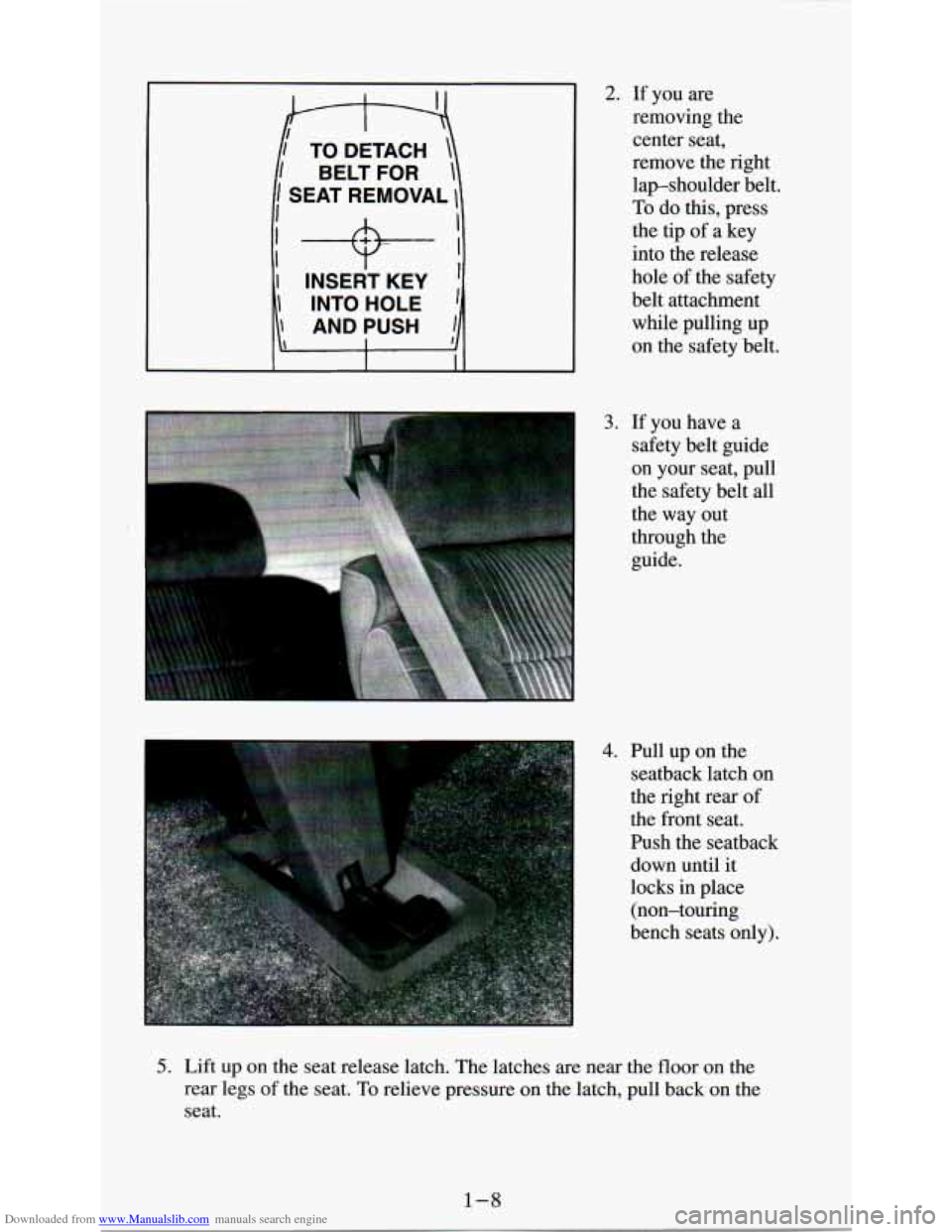
Downloaded from www.Manualslib.com manuals search engine [ TO DETACH
I BELTFOR
I SEAT REMOVAL
2. If you are
removing the
center seat,
remove the right
lapshoulder belt.
To do this, press
the tip of a key
into the release
hole of the safety
belt attachment
while pulling up
on the safety belt.
3. If you have a
safety belt guide
on your seat, pull
the safety belt all
the way out
through the
guide.
H 4. Pullup on the
seatback latch on
the right rear of
the front seat.
Push the seatback
down until it
locks in place
(non-touring
bench seats only).
5. Lift up on the seat release latch. The latches are near the floor on the
rear legs of the seat. To relieve pressure on the latch, pull back
on the
seat.
1-8
Page 28 of 340
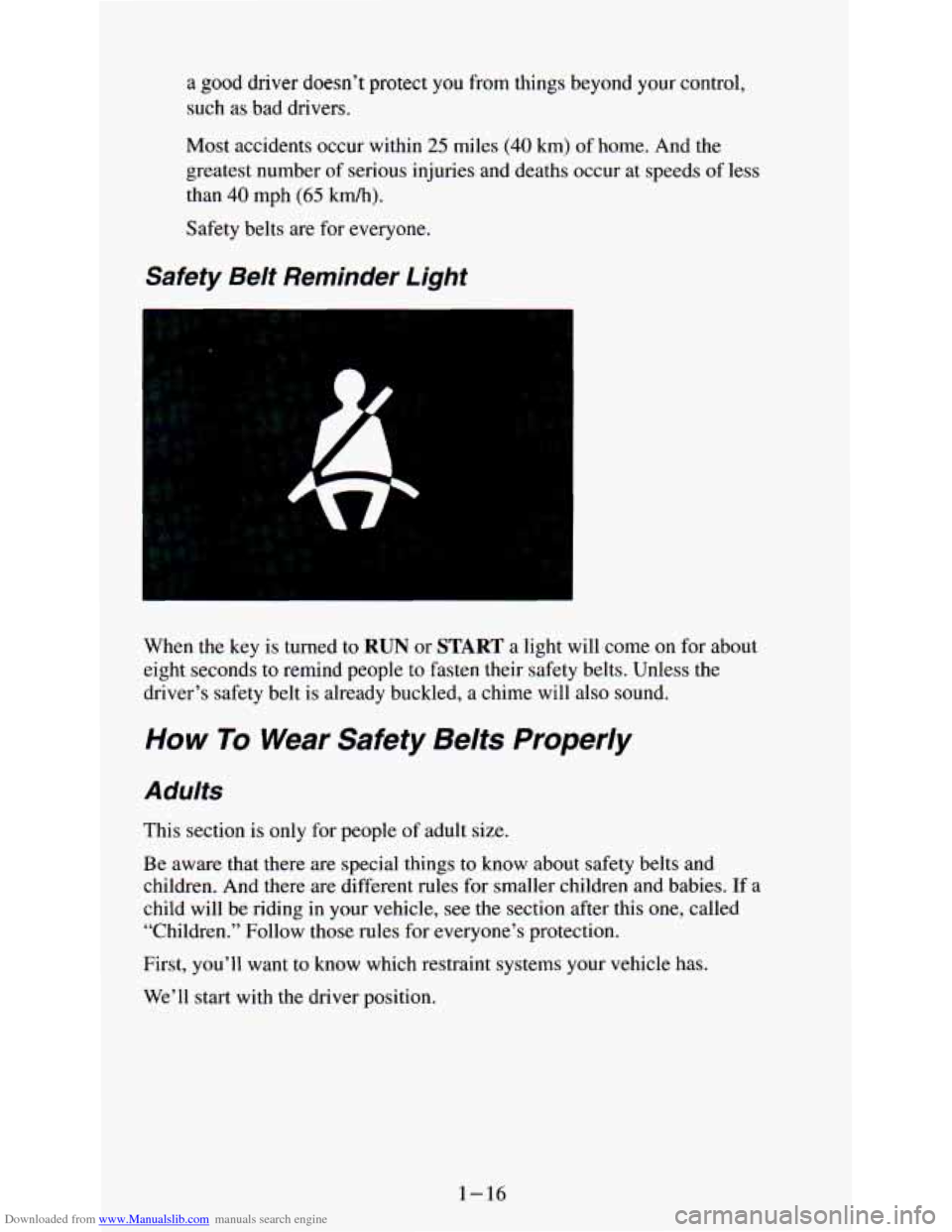
Downloaded from www.Manualslib.com manuals search engine a good driver doesn’t protect you from things beyond your control.
such as bad drivers.
Most accidents occur within
25 miles (40 km) of home. And the
greatest number of serious injuries and deaths occur at speeds
of less
than
40 mph (65 km/h).
Safety belts are for everyone.
Safety Belt Reminder Light
When the key is turned to RUN or START a light will come on for about
eight seconds to remind people
to fasten their safety belts. Unless the
driver’s safety belt
is already buckled, a chime will also sound.
How To Wear Safety Belts Properly
Adults
This section is only for people of adult size.
Be aware that there are special things to know about safety belts and
children. And there are different rules for smaller children and babies.
If a
child will be riding in your vehicle, see the section after this one, called
“Children.” Follow those rules for everyone’s protection.
First, you’ll want to know which restraint systems your vehicle has.
We’ll start with the driver position.
1-16
Page 42 of 340
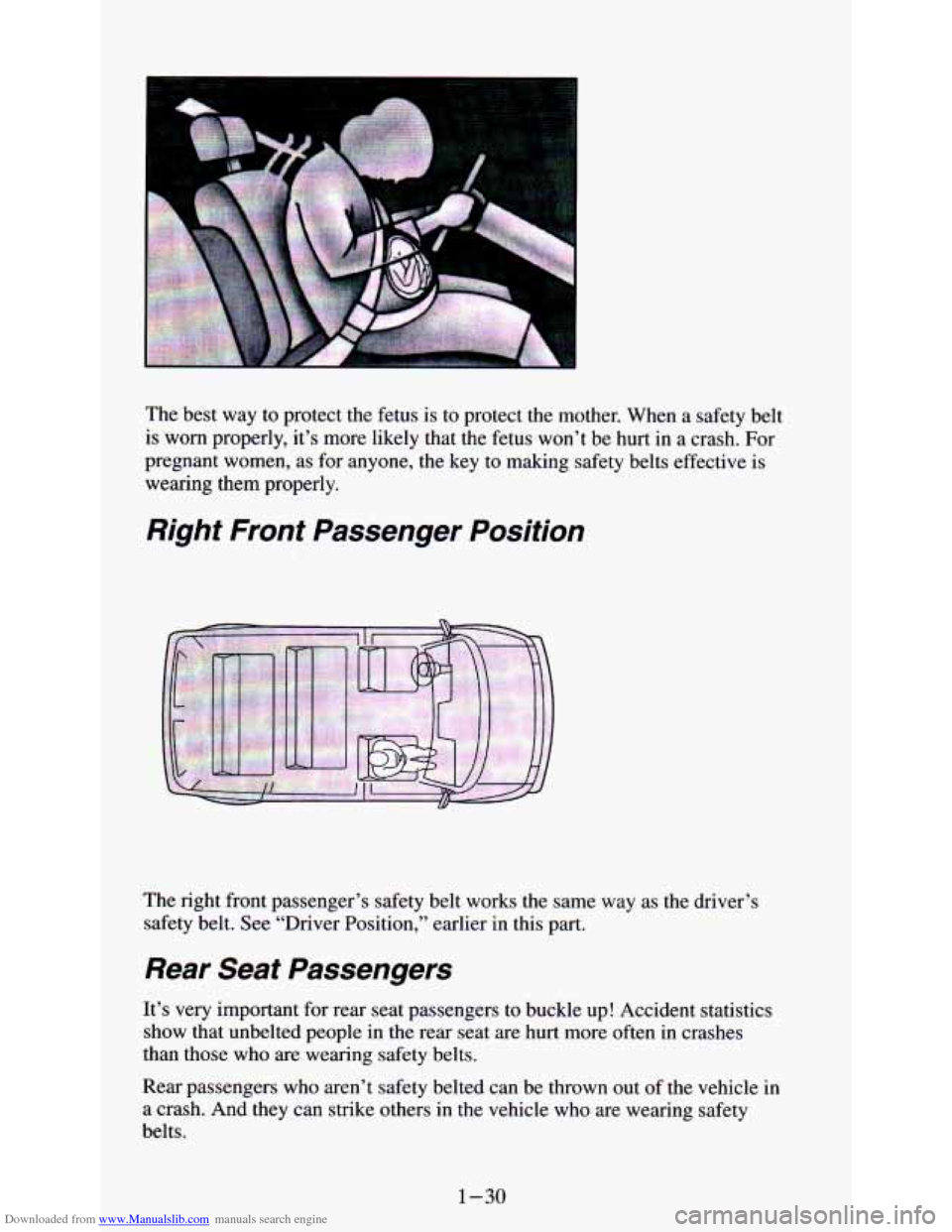
Downloaded from www.Manualslib.com manuals search engine The best way to protect the fetus is to protect the mother. When a safety belt
is worn properly, it’s more likely that the fetus won’t be hurt in a crash. For
pregnant women, as for anyone, the key to making safety belts effective is
wearing them properly.
Right Front Passenger Posjtjon
The right front passenger’s safety belt works the same way as the driver’s
safety belt. See “Driver Position,” earlier in this part.
Rear Seat Passengers
It’s very important for rear seat passengers to buckle up! Accident statistics
show that unbelted people in the rear seat are hurt more often
in crashes
than those who are wearing safety belts.
Rear passengers who aren’t safety belted can be thrown
out of the vehicle in
a crash. And they can strike others
in the vehicle who are wearing safety
belts.
1-30
Page 61 of 340
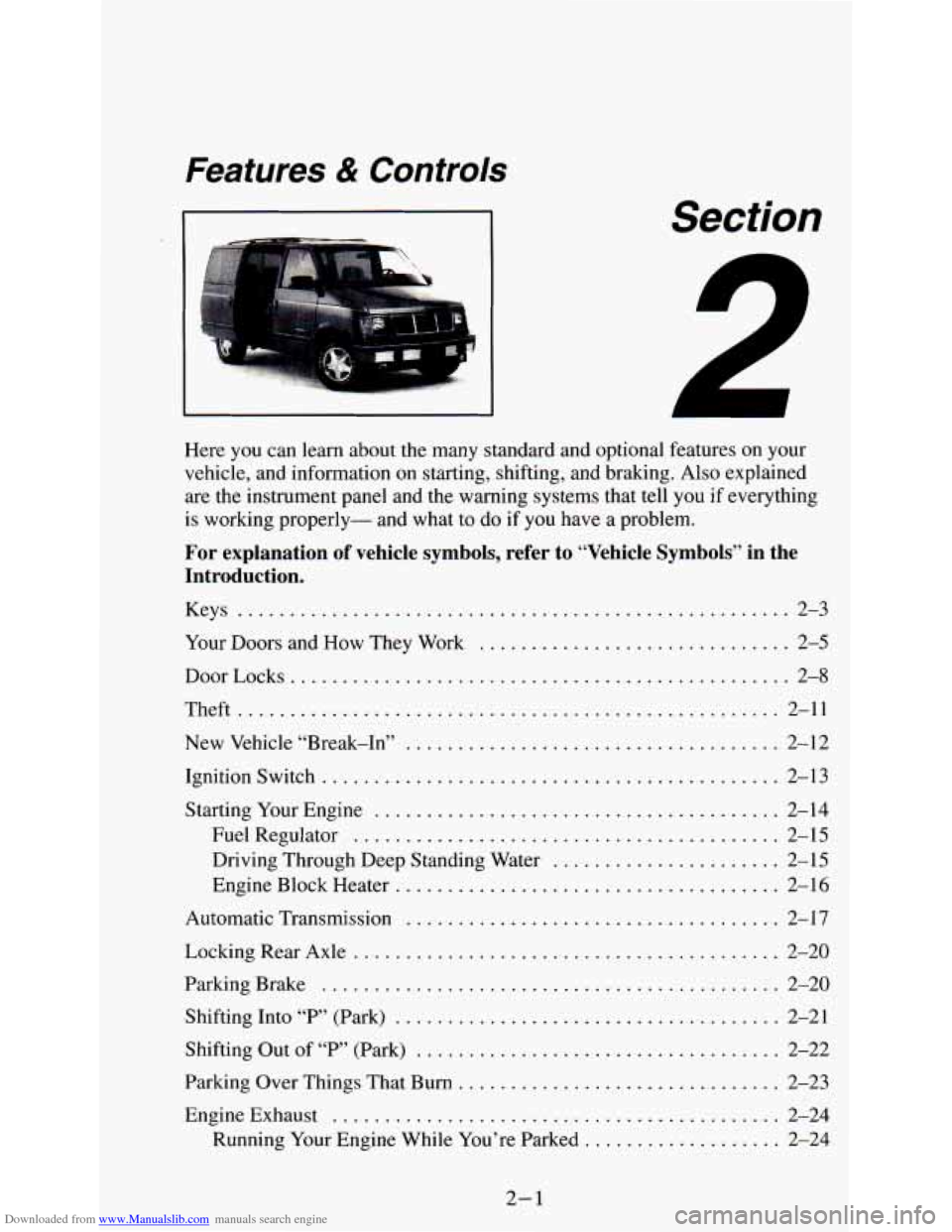
Downloaded from www.Manualslib.com manuals search engine Features & Controls
Section
A
..
Here you can learn about the many standard and optional features on your
vehicle. and information on starting. shifting. and braking
. Also explained
are the instrument panel and
the warning systems that tell you if everything
is working properly- and what to
do if you have a problem .
For explanation of vehicle symbols. refer to “Vehicle Symbols” in the
Introduction
.
Keys ................................. .................. 2-3
Your Doors and How They Work
..................... ....... 2-5
DoorLocks
................................................ 2-8
Theft
..............................................
New Vehicle “Break-In” ................. .......
. . 2-11
. . 2-12
Ignition Switch
....... ....... .......................... 2-13
Starting Your Engine
....................................... 2-14
FuelRegulator
......................................... 2-15
Driving Through Deep Standing Water
... ............... 2-15
Automatic Transmission
.................................... 2-17
Engine
Block Heater
................................... 2-16
.. ..< .. Locking Rear Axle ...................... .... 2-20
ParkingBrake
............................................ 2-20
Shifting Into
“P’ (Park) ....... .......................... 2-21
Shifting Out of “P” (Park)
................................... 2-22
Parking Over Things That Burn
............................... 2-23
EngineExhaust
.....................................
Running Your Engine While You’re Parked .............
.... 2-24
. . 2-24
2-1
Page 63 of 340
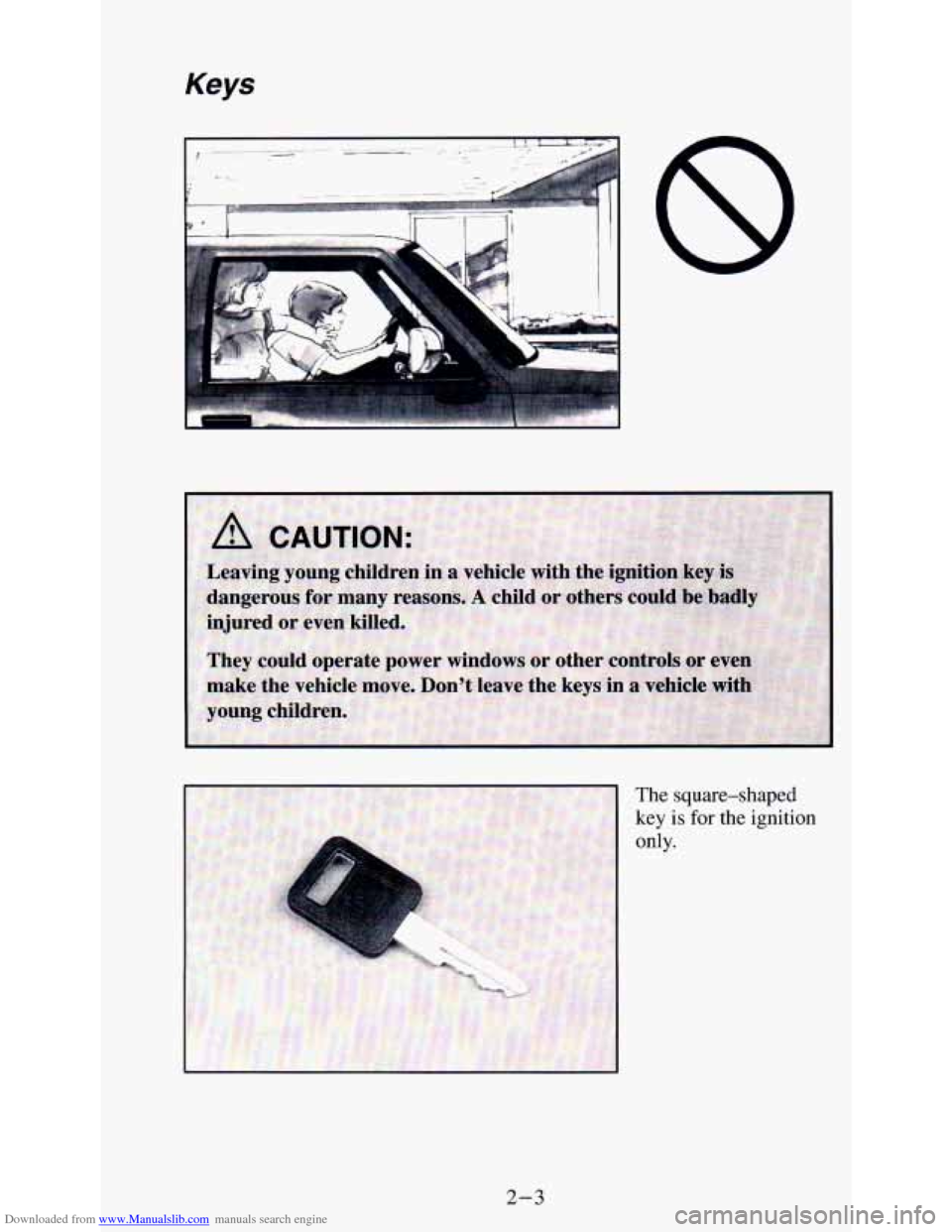
Downloaded from www.Manualslib.com manuals search engine Keys
2-3
Page 64 of 340
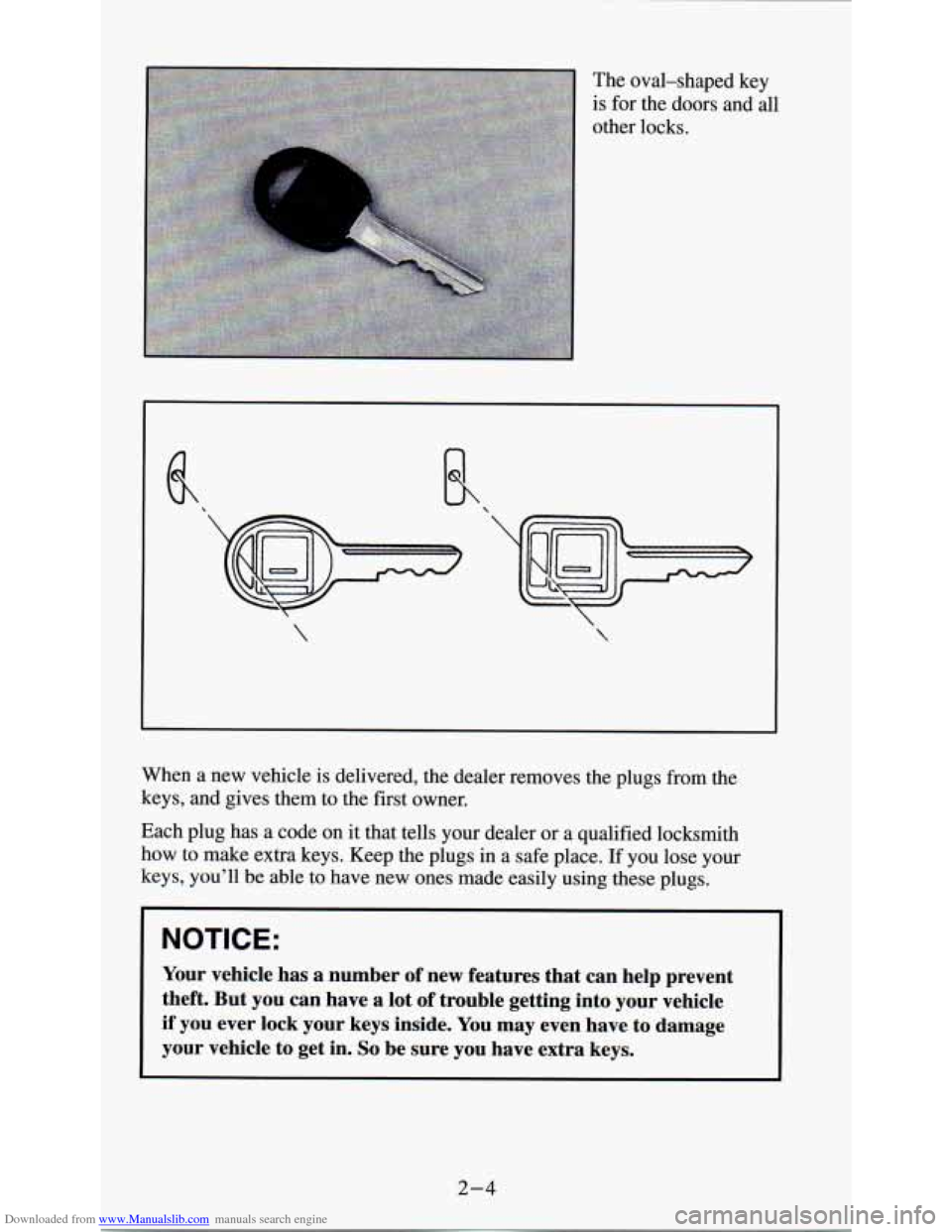
Downloaded from www.Manualslib.com manuals search engine The oval-shaped key
is for the doors and all
other locks.
K.
When a new vehicle is delivered, the dealer removes the plugs from the
keys, and gives them to the first owner.
Each plug has a code on it that tells your dealer or a qualified locksmith
how to make extra keys. Keep the plugs in a safe place. If you lose your
keys, you’ll
be able to have new ones made easily using these plugs.
NOTICE:
Your vehicle has a number of new features that can help preve\
nt
theft. But you can have
a lot of trouble getting into your vehicle
if you ever lock your keys inside. You may even have to dama\
ge
your vehicle to get
in. So be sure you have extra keys.
2-4
Page 70 of 340
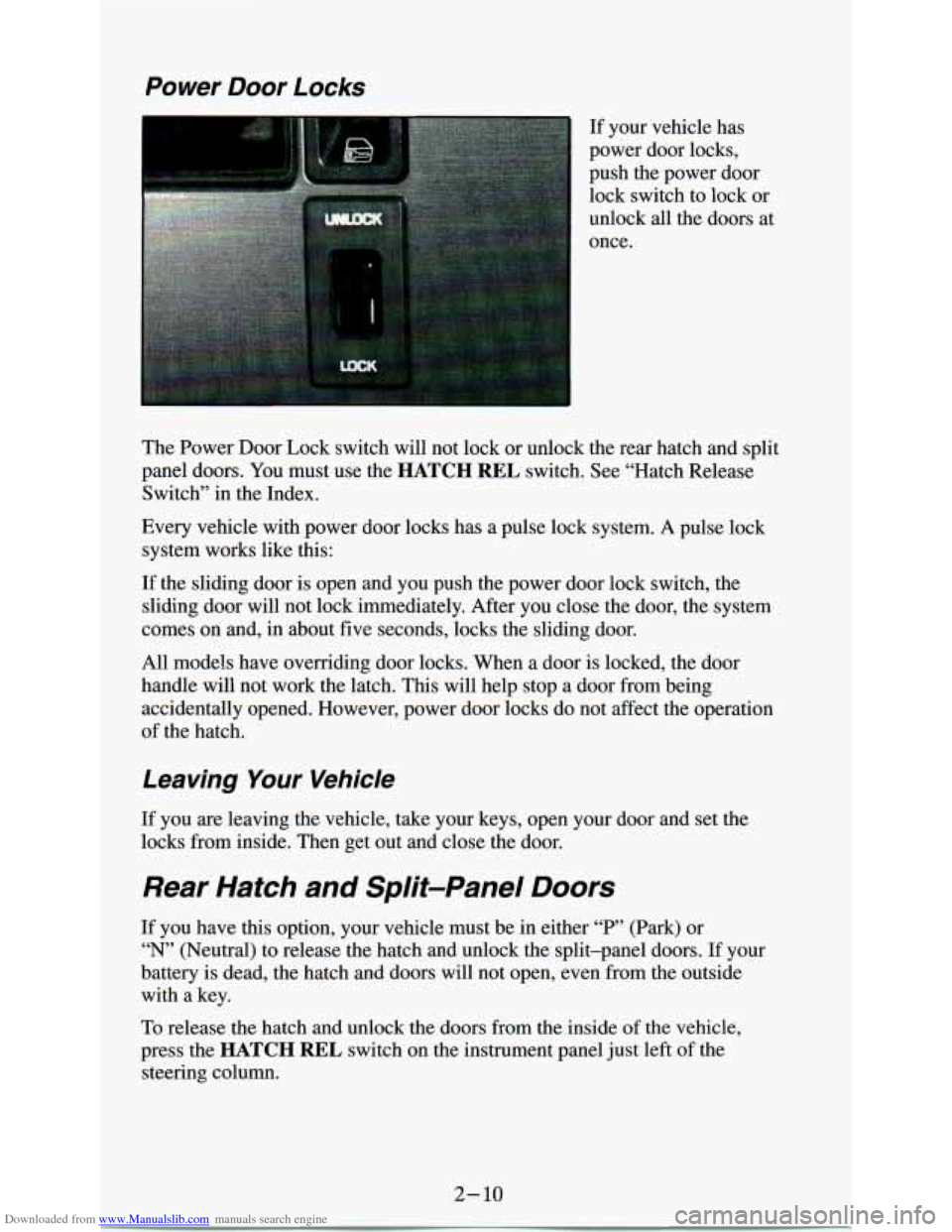
Downloaded from www.Manualslib.com manuals search engine Power Door Locks
If your vehicle has
power door locks,
push the power door
lock switch to lock or
unlock all the doors at
once.
The Power Door Lock switch will not lock or unlock the rear hatch and split
panel doors. You must use the
HATCH REL switch. See “Hatch Release
Switch” in the Index.
Every vehicle with power door locks has a pulse lock system. A pulse lock
system works like this:
If the sliding door is open and you push the power door lock switch, the
sliding door will not lock immediately. After you close the door, the system
comes on and, in about five seconds, locks the sliding door.
All models have overriding door locks. When a door is locked, the door
handle will not work the latch. This will help stop a door from being
accidentally opened. However, power door locks do not affect the operation
of the hatch.
Leaving Your Vehicle
If you are leaving the vehicle, take your keys, open your door and set the
locks from inside. Then get out and close the door.
Rear Hatch and Split-Panel Doors
If you have this option, your vehicle must be in either “P” (Park) or
“N’ (Neutral) to release the hatch and unlock the split-panel doors. If your
battery is dead, the hatch and doors will not open, even from the outside
with a key.
To release the hatch and unlock the doors from the inside of the vehicle,
press
the HATCH REL switch on the instrument panel just left of the
steering column.
2-10
Page 71 of 340
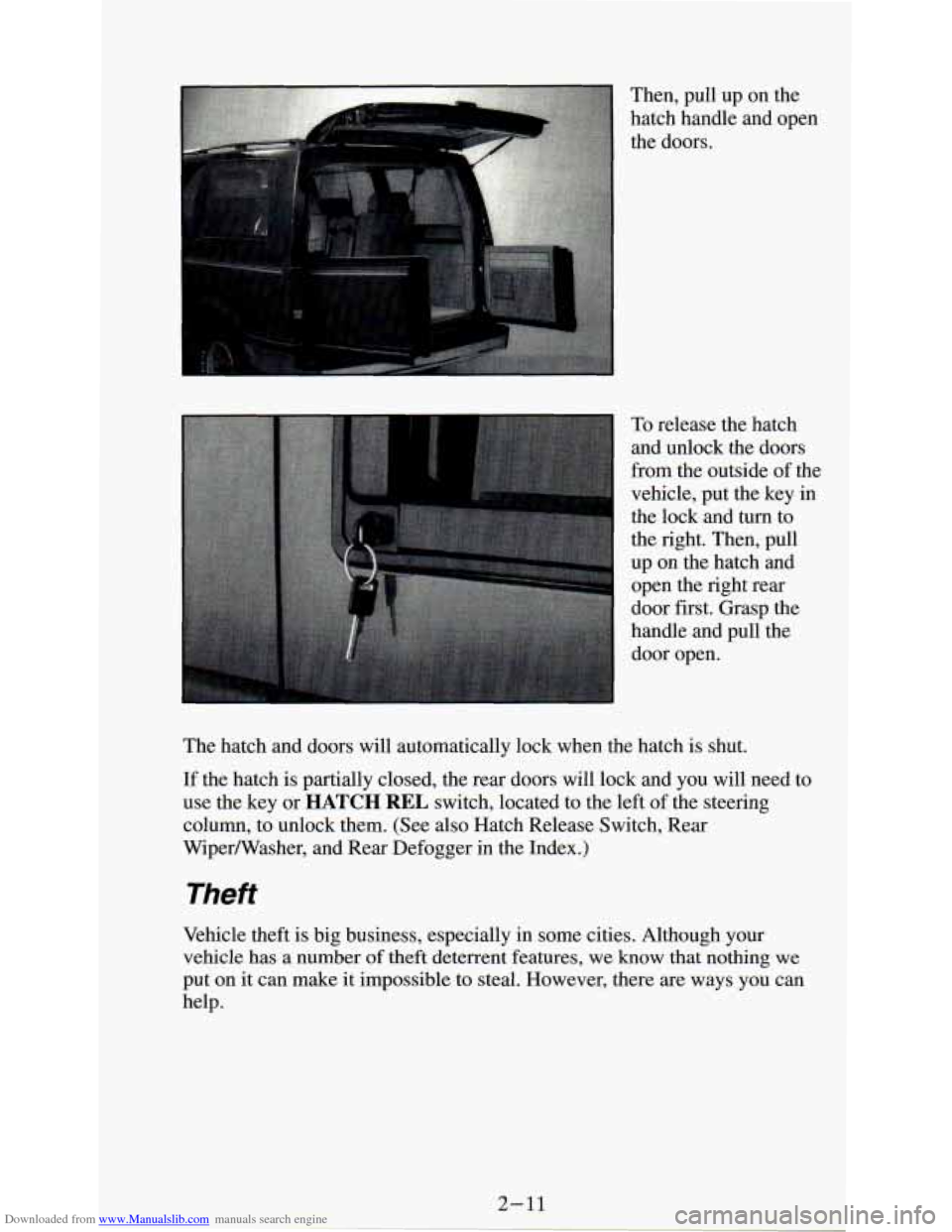
Downloaded from www.Manualslib.com manuals search engine Then, pull up on the
hatch handle and open
the doors.
To release the hatch
and unlock the doors
from the outside of the
vehicle, put the key in
the lock and turn to
the right. Then, pull
up on the hatch and
open the right rear
door first. Grasp the
handle and pull the
door open.
The hatch and doors will automatically lock when the hatch is shut.
If the hatch is partially closed, the rear doors will lock and you will need to
use the key or
HATCH REL switch, located to the left of the steering
column, to unlock them. (See also Hatch Release Switch, Rear
WiperNasher, and Rear Defogger in the Index.)
Theft
Vehicle theft is big business, especially in some cities. Although your
vehicle has
a number of theft deterrent features, we know that nothing we
put on
it can make it impossible to steal. However, there are ways you can
help.
2-11
Page 72 of 340
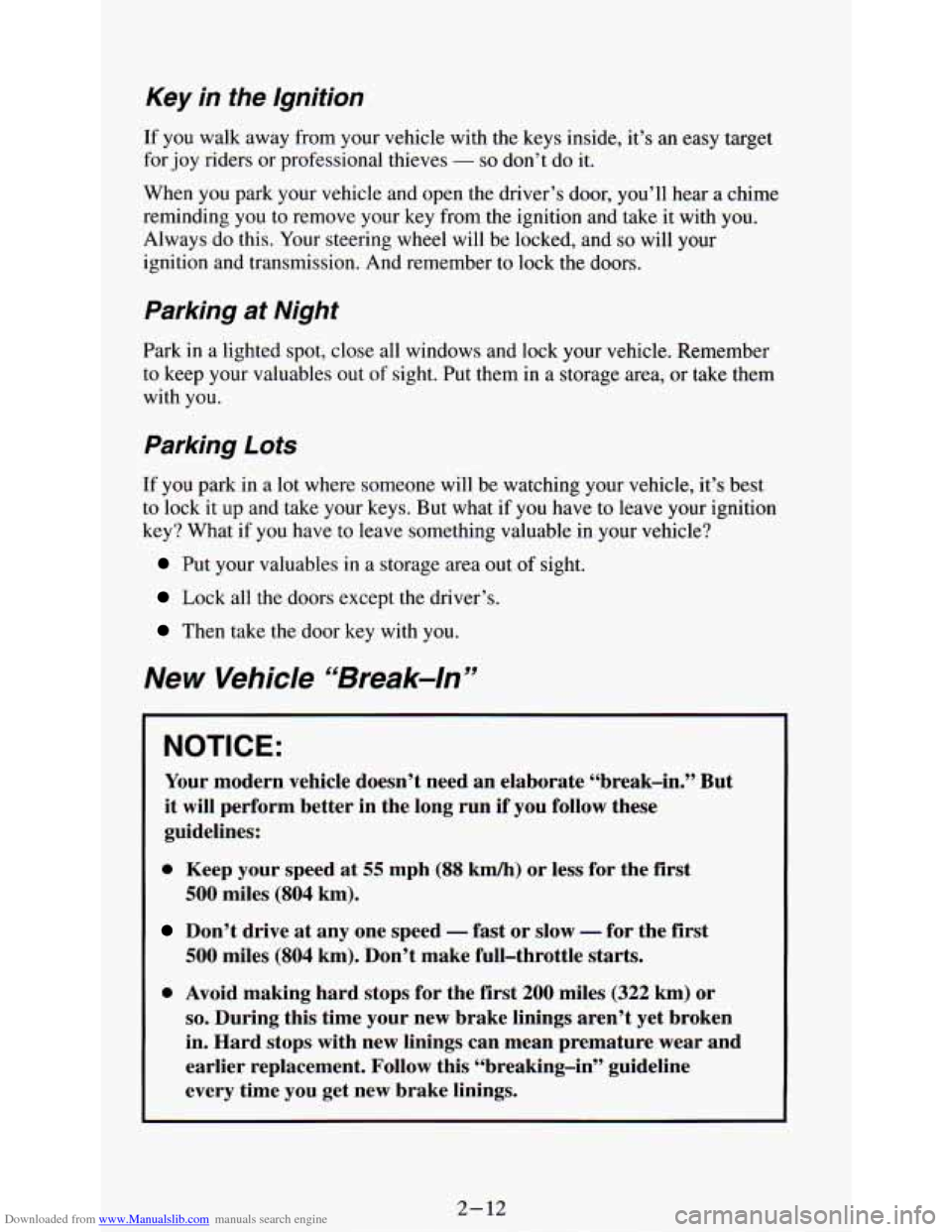
Downloaded from www.Manualslib.com manuals search engine Key in the Ignition
If you walk away from your vehicle with the keys inside, it’s an easy target
for joy riders or professional thieves
- so don’t do it.
When you park your vehicle and open the driver’s door, you’ll hear
a chime
reminding you to remove your key from the ignition and take it with you.
Always do this. Your steering wheel
will be locked, and so will your
ignition and transmission. And remember to lock the doors.
Parking at Night
Park in a lighted spot, close all windows and lock your vehicle. Remember
to keep your valuables out
of sight. Put them in a storage area, or take them
with you.
Parking Lots
If you park in a lot where someone will be watching your vehicle, it’s best
to lock
it up and take your keys. But what if you have to leave your ignition
key? What
if you have to leave something valuable in your vehicle?
Put your valuables in a storage area out of sight.
Lock all the doors except the driver’s.
Then take the door key with you.
New Vehicle “Break-In ”
NOTICE:
Your modern vehicle doesn’t need an elaborate “break-in.” But
it will perform better in the long run if you follow these
guidelines:
0 Keep your speed at 55 mph (88 km/h) or less for the first
500 miles (804 km).
Don’t drive at any one speed - fast or slow - for the first
500 miles (804 km). Don’t make full-throttle starts.
0 Avoid making hard stops for the first 200 miles (322 km) or
so. During this time your new brake linings aren’t yet broken
in. Hard stops with new linings can mean premature wear and
earlier replacement. Follow this “breaking-in” guideline
every time you get new brake linings.
2-12
Page 73 of 340
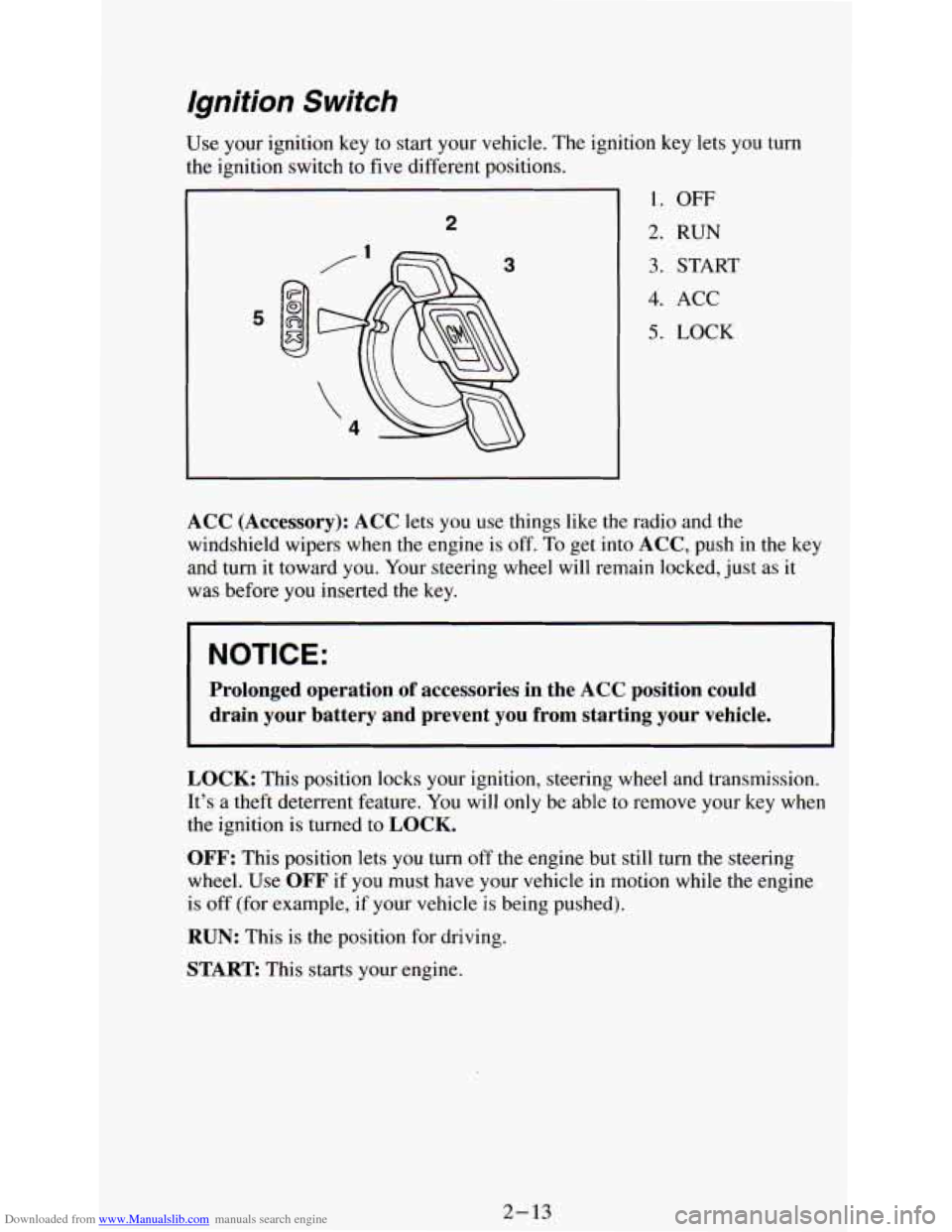
Downloaded from www.Manualslib.com manuals search engine Ignition Switch
Use your ignition key to start your vehicle. The ignition key lets YOU turn
the ignition switch to five different positions.
3
1. OFF
2. RUN
3. START
4. ACC
5. LOCK
ACC (Accessory): ACC lets you use things like the radio and the
windshield wipers when the engine is off. To get into
ACC, push in the key
and turn it toward you. Your steering wheel will remain locked, just as it
was before you inserted the
key.
NOTICE:
Prolonged operation of accessories in the ACC position could
drain your battery and prevent you from starting your vehicle. \
LOCK:
This position locks your ignition, steering wheel and transmission.
It’s a theft deterrent feature. You will only be able to remove your key when
the ignition is turned to
LOCK.
OFF: This position lets you turn off the engine but still turn the steering
wheel. Use
OFF if you must have your vehicle in motion while the engine
is off (for example, if your vehicle is being pushed).
RUN: This is the position for driving.
START This starts your engine.
2-13